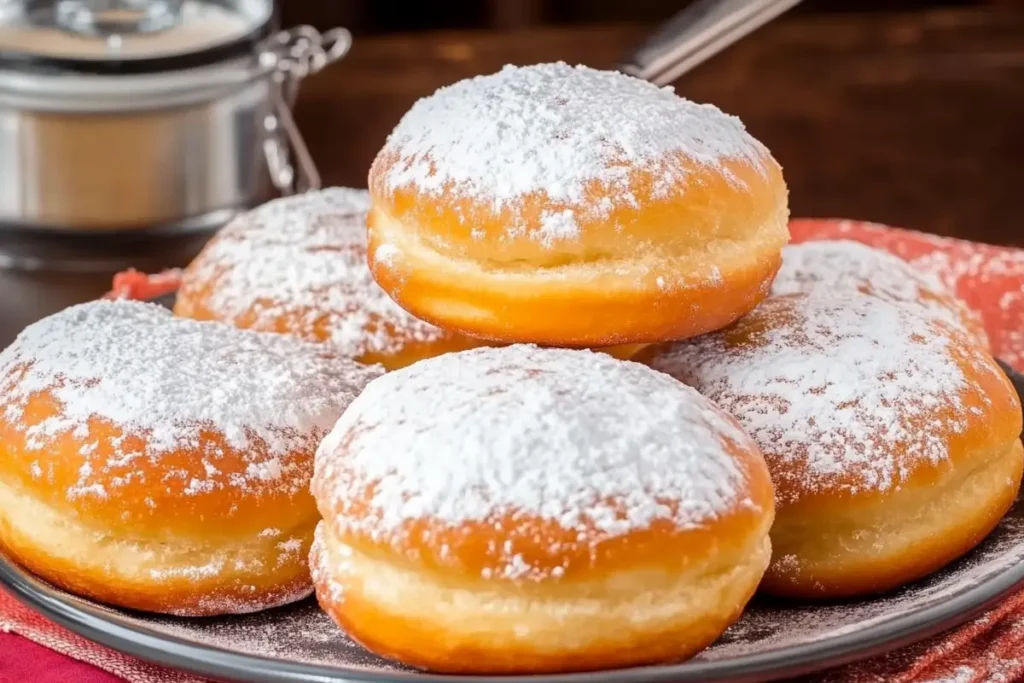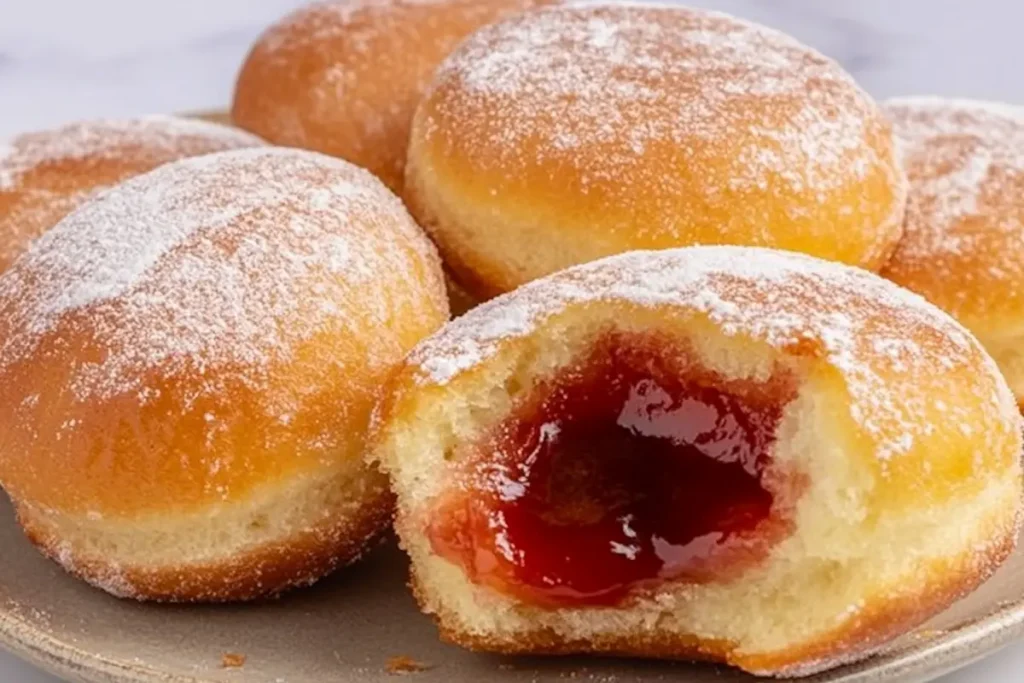Last Updated on March 5, 2025 by Simon
Imagine biting into a warm, fluffy beignet, its golden edges dusted with a cloud of powdered sugar that melts on your tongue. The first bite is pillowy, sweet, and utterly divine—a culinary moment that takes you straight to the heart of New Orleans. For many, beignets aren’t just a dessert; they’re a cultural experience, a ritual, a moment to savor. But here’s the question: what’s the secret to making beignets that rival those from the iconic Café du Monde?
In this guide, we’re uncovering all the tips and tricks to achieve perfection in every bite. Whether you’re an experienced baker or a kitchen newbie, you’ll learn exactly how to craft these sweet French-inspired fritters. The secret isn’t just in the recipe; it’s in the technique. From getting the dough just right to nailing that perfect golden fry, I’ll walk you through every step.
Why will you love this recipe? Because beignets are a treat for all occasions, breakfast, dessert, or even a festive snack. Their airy texture pairs beautifully with coffee, and they’re a hit at parties and brunches. Plus, they’re surprisingly simple to make when you know the tricks. Ready to unlock the secret to perfect beignets? Let’s get started!
Table of contents
Why This Recipe Works

What sets a perfect beignet apart from a mediocre one? It’s all about balance: airy yet substantial, sweet but not cloying, crispy on the outside yet soft on the inside. Here’s what makes this recipe exceptional:
1. The Perfect Dough
The dough is the soul of the beignet. A combination of bread flour and all-purpose flour creates just the right structure, offering enough gluten to hold its shape while remaining tender. A small amount of sugar in the dough not only adds flavor but also helps achieve a beautiful golden-brown crust during frying.
Using milk instead of water for the liquid component adds richness, while butter gives a melt-in-your-mouth quality. For extra flavor, a touch of vanilla extract or orange zest is added, providing a subtle yet delightful twist.
2. Controlled Proofing
One of the secrets to fluffy beignets is proper proofing. Allowing the dough to rise in a warm, draft-free spot develops both texture and flavor. The yeast ferments the sugars, creating those tiny air pockets that expand during frying. Too short a proofing time, and your beignets will be dense; too long, and they’ll collapse. This recipe ensures the perfect balance.
3. Precise Frying Technique is an important secret in making beignets
Frying can make or break a beignet. The oil temperature must be spot-on, 370°F (188°C) is the magic number. Frying at this temperature ensures that the beignets puff up beautifully, cooking evenly inside and out without absorbing too much oil. The result? A golden, light, and crispy exterior encasing a fluffy interior.
4. Signature Powdered Sugar Coating
The powdered sugar isn’t just decoration, it’s a vital component of the beignet experience. Sifting the sugar before dusting ensures a light, even coating that sticks to the warm beignets. The result is a perfect balance of sweetness that enhances but never overpowers.
5. Customizable for Every Occasion
This recipe is versatile, making it easy to tailor to your preferences or dietary needs. Want a gluten-free option? Substitute gluten-free flour blends and a bit of xanthan gum for elasticity. Need a vegan version? Replace milk with almond or oat milk and butter with coconut oil or vegan butter. These adjustments don’t compromise the flavor or texture, they’re are another key secret to making beignets at home.
6. Unbeatable Freshness
Freshness is key when it comes to beignets. They’re at their best minutes after frying, when they’re still warm and airy. That said, I’ll share tips for storing and reheating them later in the article, so you can still enjoy them if you have leftovers.
How to Apply These Secrets in making Beignets and Avoid Common Mistakes

Let’s delve deeper into how you can put these secrets into action and sidestep pitfalls that might otherwise derail your beignet-making journey.
1. Mastering the Dough Consistency Beignets Secret
Application:
- Use bread flour for elasticity and structure while combining it with a bit of all-purpose flour for tenderness.
- Mix the dough until just combined. Over-kneading can over-develop gluten, making the beignets tough. Aim for a smooth, soft texture that’s slightly tacky but not sticky.
- Let the dough rest for about 10 minutes before kneading, allowing the gluten to relax for easier shaping.
Mistakes to Avoid:
- Overworking the dough: This leads to dense, chewy beignets. Mix only until the dough comes together smoothly.
- Too much flour: Adding extra flour to compensate for stickiness can make the dough too stiff. Work on a lightly floured surface instead of over-flouring the dough itself.
2. Perfecting the Proofing Process Beignets Secret
Application:
- Cover the dough with plastic wrap or a damp kitchen towel during proofing to prevent it from drying out.
- Place the dough in a warm, draft-free area for proofing. An oven with the light turned on (not the heat!) works perfectly.
- Proof the dough until it’s doubled in size, this usually takes 1–2 hours, depending on your room temperature.
Mistakes to Avoid:
- Under-proofing: Your beignets won’t puff up properly during frying, leading to a dense texture. Ensure the dough has visibly risen.
- Over-proofing: Overproofed dough can collapse during frying, causing flat or greasy beignets. Check the dough periodically to avoid letting it rise too much.
3. Nail the Frying Technique is yet another secret in Making Beignets
Application:
- Use a thermometer to maintain the oil temperature at 370°F (188°C).
- Fry in small batches to keep the oil temperature consistent. Overcrowding the fryer will lower the temperature, resulting in soggy, undercooked beignets.
- Gently drop the dough into the oil to avoid splashes, and flip each beignet halfway through frying using a slotted spoon.
Mistakes to Avoid:
- Guessing oil temperature: Without a thermometer, you’re likely to end up with uneven cooking. A thermometer is your best friend here!
- Skipping oil changes: If you’re making a large batch, oil quality can deteriorate over time. If you notice excessive browning or smoke, replace the oil.
- Over-frying: Beignets only need about 2–3 minutes per side. Cooking too long results in a dry interior.
4. Achieving the Perfect Powdered Sugar Finish
Application:
- Dust the beignets while they’re still warm to ensure the sugar sticks. Use a sifter for even coverage.
- For a café-quality presentation, go heavy on the powdered sugar, it should create a light, fluffy layer over the beignets.
Mistakes to Avoid:
- Adding sugar too early: Dusting before frying can cause clumping and burning. Always wait until after frying.
- Too little sugar: The sugar balances the slight savoriness of the dough. Don’t skimp!
5. Customizing for Dietary Preferences Beignets Secret
Application:
- For gluten-free beignets, use a 1:1 gluten-free baking flour blend with xanthan gum for structure.
- To make them vegan, replace milk with oat or almond milk and butter with a high-quality vegan alternative or coconut oil.
Mistakes to Avoid:
- Skipping adjustments for substitutions: For example, gluten-free flours require additional stabilizers like xanthan gum. Without it, the dough can fall apart.
6. Timing and Freshness Beignets Secret
Application:
- Fry beignets as close to serving time as possible. They’re best when fresh and warm.
- If making ahead, allow them to cool completely, store in an airtight container, and reheat in the oven at 350°F (175°C) for 5 minutes before dusting with fresh powdered sugar.
Mistakes to Avoid:
- Storing improperly: Beignets left uncovered will dry out quickly, while airtight storage without cooling first can make them soggy.
- Serving cold: Beignets lose their magic once they cool completely. Always serve warm if possible.
Additional Expert Secret in making Beignets
- Cut Consistently: Use a sharp knife or pizza cutter to create even squares or rectangles. This ensures uniform frying.
- Avoid Splashes: When adding dough to the oil, use a slotted spoon or lower it gently to prevent dangerous splatters.
- Rest Before Frying: Let the cut beignets rest for 10 minutes before frying. This gives the gluten time to relax and ensures even puffing.
FAQ to Secret in making Beignets.
Beignets need properly proofed dough and the right frying temperature to puff up. If your oil is too cold, the beignets won’t expand as they should. Similarly, under-proofed dough doesn’t develop enough air pockets to create that airy texture. Double-check that your oil is heated to 370°F (188°C) and allow the dough to rise until it doubles in size.
Yes! A heavy-bottomed pot or Dutch oven works perfectly for frying beignets. Just make sure the pot is deep enough to allow the beignets to float and that you use a thermometer to monitor the oil temperature.
Absolutely. You can make the dough a day ahead and store it in the refrigerator, covered with plastic wrap. Let it come to room temperature for about 30 minutes before rolling out and frying. The cold fermentation process can actually enhance the flavor of the dough!
Greasy beignets are usually the result of oil that’s too cool. Be sure your oil is consistently heated to 370°F (188°C). Overcrowding the pot can also lower the temperature, so fry in small batches.
Dust the beignets immediately after frying while they’re still warm. The heat helps the sugar adhere, creating that iconic snowy coating. Use a fine-mesh sieve to sprinkle the sugar evenly.
Not quite! While they’re both fried dough, beignets have a lighter, airier texture and are traditionally square-shaped with no hole in the center. Donuts often have a denser crumb and can be glazed or filled, while beignets rely on a liberal coating of powdered sugar for their sweetness.
Why You Should Try Making Beignets Today?
Beignets are more than just a sweet treat; they’re a ticket to indulgence, an ode to the vibrant culture of New Orleans. Hence, whether you’re serving them for breakfast, dessert, or as a festive snack, these fluffy, golden pillows of joy bring a touch of magic to any table.
The beauty of making beignets lies in their simplicity. With just a few ingredients and some tried-and-true techniques, you can recreate the charm of a French Quarter café right in your own kitchen. Imagine gathering friends and family, serving up a tray of warm, sugar-dusted beignets alongside steaming mugs of coffee or hot chocolate. It’s the kind of experience that lingers in memory and brings people together.
If you’ve never tried making beignets, now’s the perfect time to give it a go. Armed with these tips, you’ll avoid the pitfalls and achieve the lightest, fluffiest results. And once you’ve mastered the basics, then the possibilities are endless. Think flavored sugars, creative toppings, or even savory variations.
So, roll up your sleeves, warm up the oil, and get ready to experience the sweet satisfaction of homemade beignets. Your taste buds (and your guests) will thank you!

